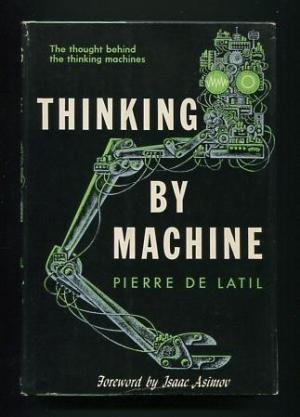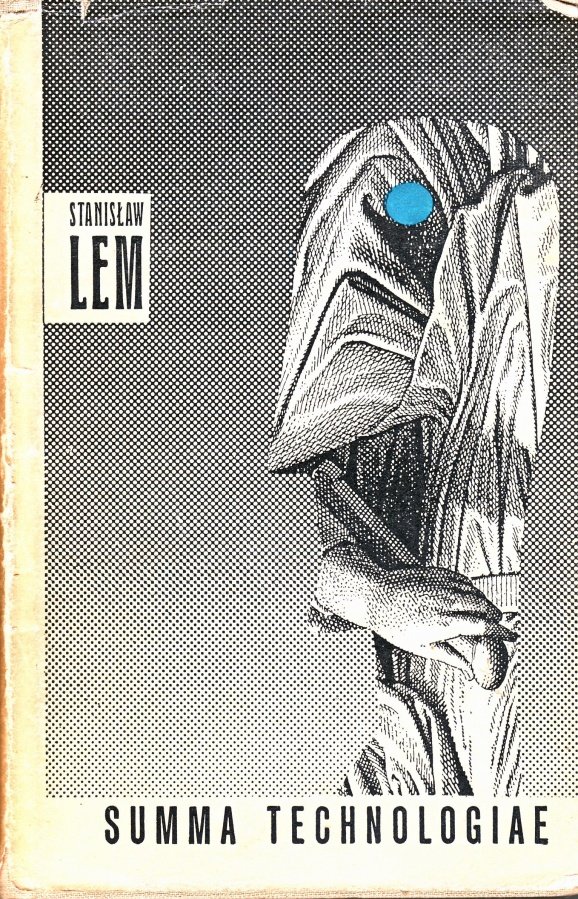Tauchain over de Latil
''Thinking by Machine: A Study of Cybernetics''
by Pierre de Latil [1]
Published by Houghton Mifflin Company in 1957 (c.1956), Boston.
Foreword of Isaac Asimov (then only 36 years old) ! Recommendation by the legendary mathematician and cyberneticist Norbert Wiener (then 62 years old) ! ... A true jewel! The book is described as:
A review of "the last ten years' progress in the development of self-governing machines," describing "the principles that make the most complex automatic machines possible, as well as the fundamentals of their construction."
Nineteen fifties !! The midway between the first digital computer made by my half-compatriot John Atanasoff [2] and internet [3]. Almost a human generation span between the former, the book and the later event. Epoch so deep in the past that even television, air travel, rockets and nukes ... were young then.
Same Kondratieff [4] wave phase btw, which hints towards the historical rhyming of socially important intellectual interests. (On how K-waves imprint on the humanity growth curve - in series of other posts to come).
I must admit here that I've never put my hands and eyes onto this book. But, it is stamped into my mind and memory by Stanislaw Lem [5] - one of the greatest philosophers of the XXth century, working under the disguise of a Sci-Fi writer, for being caught on the wrong side of the Iron curtain.
''Summa Technologiae'' (1964) [6] is a monumental work of Lem's, where most issues discussed sound more contemporary nowadays than they were the more than half a century ago when it was built, and for many things also we are yet in the deep past ...
... Lem reports and discussed the following from the aforementioned Pierre de Latil's book.:
''As a starting point will serve a graphic chart classifying effectors, i.e., systems capable of acting, which Pierre de Latil included in his book Artificial Thinking [P. de Latil: Sztuczne mys´lenie. Warsaw 1958]. He distinguishes three main classes of effectors. To the first, the deterministic effectors, belong simple (like a hammer) and complex devices (adding machine, classical machines) as well as devices coupled to the environment (but without feedback) - e.g. automatic fire alarm. The second class, organized effectors, includes systems with feedback: machines with built-in determinism of action (automatic regulators, e.g., steam engine), machines with variable goals of action (externally conditioned, e.g., electronic brains) and self-programming machines (system capable of self-organization). To the latter group belong the animals and humans. One more degree of freedom can be found in systems which are capable, in order to achieve their goals, to change themselves (de Latil calls this the freedom of the "who", meaning that, while the organization and material of his body "is given" to man, systems of that higher type can - being restricted only with respect to the choice of the building material - radically reconstruct the organization of their own system: as an example may serve a living species during biological evolution). A hypothetical effector of an even higher degree also possesses the freedom of choice of the building material from which "it creates itself". De Latil suggests for such an effector with highest freedom - the mechanism of self-creation of cosmic matter according to Hoyle's theory. It is easy to see that a far less hypothetical and easily verifiable system of that kind is the technological evolution. It displays all the features of a system with feedback, programmed "from within", i.e., self-organizing, additionally equipped with freedom with respect to total self-reconstruction (like a living, evolving species) as well as with respect to the choice of the building material (since a technology has at its disposal everything the universe contains).
I gave only a short summary of the classification of systems with increasing number of degrees of freedom of action as suggested by de Latil, removing from it some highly contestable details of the division. Before we go on to further considerations, it is probably not inappropriate to remark that the presented classification is not complete. One could imagine systems with yet another degree of freedom: for the choice of materials in the universe is necessarily limited by the "catalogue of goods" which are at disposal. However, a system is conceivable which, not satisfied with the range of available things, creates materials "beyond the catalogue", not yet existing in the universe. The theosophist might be inclined to take God for such a "self-organizing system with maximum freedom"; this hypothesis, however, is not indispensable to us, because we can assume, even on the basis of our modest contemporary knowledge, that the creation of "parts beyond the catalogue" (e.g., certain subatomic particles which "normally" do not occur in the universe) is possible. Why? Because the universe does not produce every possible material structure, and it is well known that it does not create, e.g. in stars, nor somewhere else, typewriters; nevertheless the "potential" for such devices is there - and the same, one can imagine, is true for phenomena concerning states of matter and energy in the supporting space-time which cannot be realized by the universe (at least not in the current phase of its existence).''
Longish quote, but every word in it is a worth. When I've read this as a kid back in 1980es ... immediately came to my mind the next, the seventh logical higher effector class.: the worldmaker !!
The degrees of freedom of all the previous six according to the classical taxonomy of de Latil are confined by the rule-set, the local laws of physics.
They are prisoners of an universe. Like birds incapable to reconfig their cage into roomier and cozier ones.
If we regard the laws of nature as code or algorithm, my 7th level effector will be capable to draft and implement itself onto newer and stronger algorithmic foundations. ( Note the seamlessness between computation and robotics in Latil/Lem categorization construct - quite logical indeed, having in mind that software is state of hardware, that matter-form-action are inextricable from each other, but on this in series of other times and posts ... ). Without bond?
So, I wonder:
Where, you reckon, is Tauchain [7] placed onto the Latil's effectors map?
References:
- [1] - https://fr.wikipedia.org/wiki/Pierre_de_Latil
- [2] - https://en.wikipedia.org/wiki/John_Vincent_Atanasoff
- [3] - https://en.wikipedia.org/wiki/Internet_protocol_suite#Early_research
- [4] - https://en.wikipedia.org/wiki/Kondratiev_wave
- [5] - https://en.wikipedia.org/wiki/Stanis%C5%82aw_Lem
- [6] - https://publicityreform.github.io/findbyimage/readings/lem.pdf
- [7] - http://www.idni.org/blog/agoras-to-tml
18qSKUUTAGw1uL53simrSiZ6pJpfxKACvj for research support. Thanks.
Copyright © 2018 Georgi Karov. All rights reserved.

